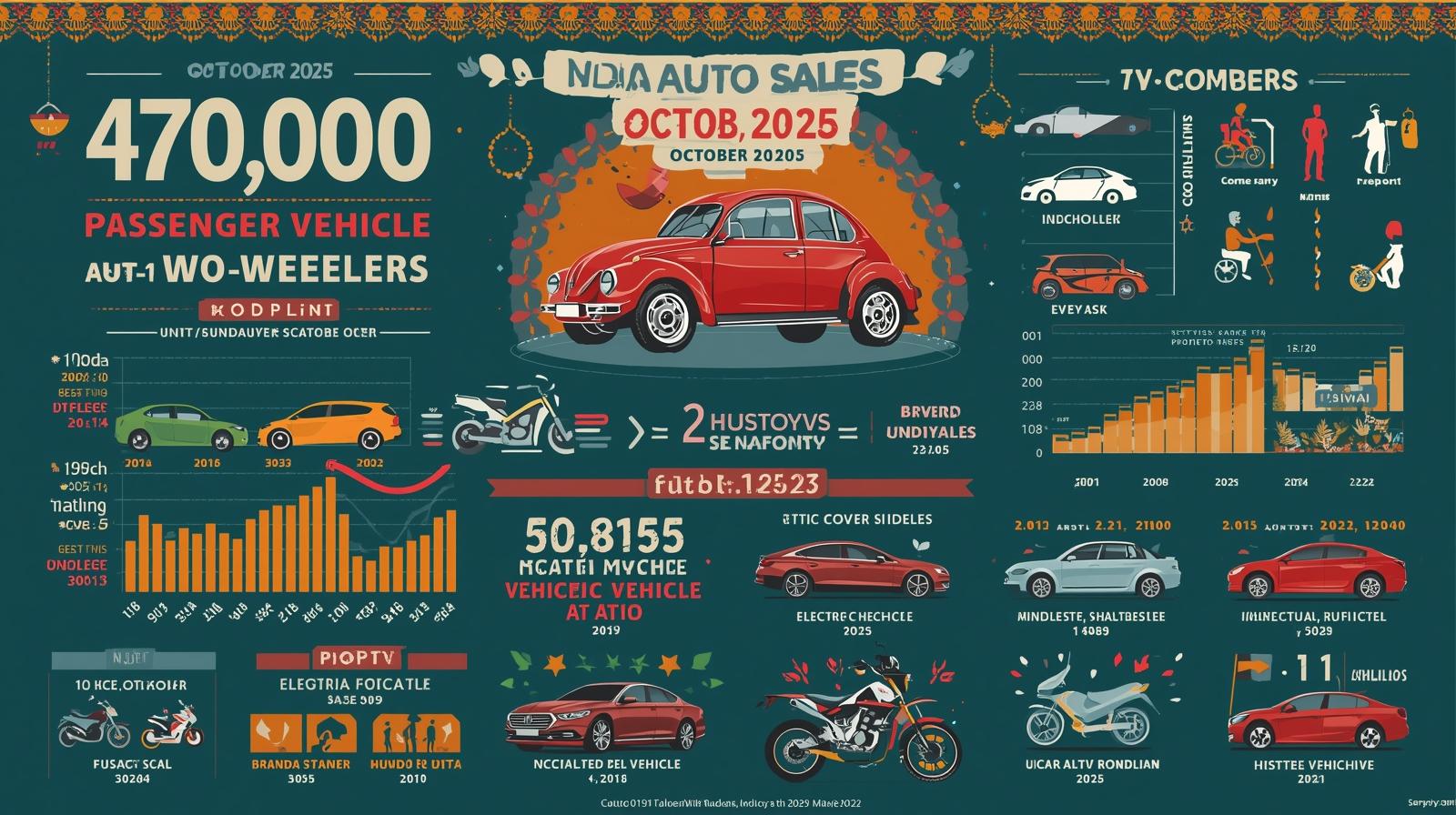Auto sales October 2025-Overview:
October 2025 turned out to be one of the strongest months ever for India’s automotive industry. Passenger vehicle sales hit a historic high, crossing 470,000 units, marking a 17% year-on-year growth. The festive season, combined with the government’s new GST 2.0 structure, gave the sector a substantial lift across all categories — passenger vehicles (PVs), commercial vehicles (CVs), two-wheelers, and electric mobility.
The automotive sector, a key pillar of India’s manufacturing and GDP, showed clear signs of sustained demand recovery. Automakers from Maruti Suzuki, Hyundai, Tata Motors, Mahindra & Mahindra, Honda, Bajaj Auto, TVS Motor, Hero MotoCorp, and others reported strong sales momentum. Electric vehicles (EVs) and SUVs continued to dominate buyer preferences, reflecting India’s ongoing mobility transformation.
Passenger Vehicle Segment: New Heights Achieved
The passenger vehicle (PV) segment recorded an all-time high in wholesales of approximately 4.7 lakh units in October 2025, the highest monthly tally in Indian automotive history. Compared to October 2024, when PV sales were around 4 lakh units, this represents a 17% increase.
Key Drivers of PV Growth
- Festive Season Boost – Dussehra and the onset of Diwali buying sentiment created robust showroom traffic and retail sales.
- GST 2.0 Reforms – The central government’s mid-year GST restructuring reduced the effective tax on compact SUVs and mid-sized sedans, leading to more competitive pricing.
- New Model Launches – Companies launched multiple models and variants, such as new trims of the Tata Nexon, Maruti Fronx, Hyundai Creta facelift, and Mahindra’s Thar EV concept rollout.
- Dealer Stocking for Festive Sales – Carmakers pushed record wholesale dispatches to dealers ahead of the extended festive window.
Company-wise Breakdown
1. Maruti Suzuki India Ltd.
Maruti Suzuki retained its dominance with 176,318 units dispatched in October 2025, up 10.5% year-on-year. Retail deliveries crossed 242,000 units, reflecting healthy offtake from dealerships.
The company benefited from high bookings for models like the Baleno, Brezza, Grand Vitara, and the newly launched Swift Hybrid. The smaller Alto and WagonR segments also saw recovery as rural demand improved due to higher rabi crop income.
Maruti also reported a rise in export volumes, sending around 20,000 units abroad, mainly to Latin America and Africa.
2. Hyundai Motor India
Hyundai sold a total of 69,894 units during the month, including 53,792 domestic and 16,102 export units. Domestic sales rose roughly 8% YoY as demand for the Creta, Venue, and i20 models remained strong.
Hyundai is now focusing on increasing its EV footprint with the upcoming Creta EV, expected to launch in early 2026.
3. Tata Motors Ltd.
Tata Motors reported 61,134 passenger vehicles, marking a 27% increase year-on-year. The company saw strong performance in both ICE and electric categories, led by the Nexon, Punch, and Tiago EV.
Tata continues to dominate the EV market in India with a share of over 72% among four-wheelers. October saw strong EV bookings, aided by lower EMIs due to recent repo rate cuts.
4. Mahindra & Mahindra (M&M)
Mahindra’s SUV portfolio once again outperformed, delivering 71,624 units, reflecting an impressive 31% YoY growth. The Scorpio, XUV700, Bolero Neo, and Thar models drove demand.
The company’s pending order book crossed 200,000 units, showcasing sustained interest in SUVs despite long waiting periods. Mahindra’s farm equipment division also performed well, with tractor sales showing double-digit growth during the festive period.
5. Toyota Kirloskar Motor
Toyota’s monthly volumes crossed 27,000 units, up 15% YoY, fueled by high demand for the Innova Hycross, Urban Cruiser Taisor, and the Glanza. Toyota also saw strong hybrid sales, cementing its position as the top hybrid carmaker in India.
6. Honda Cars India
Honda recorded modest growth with 9,100 units in October 2025, up from 8,200 units last year. The new Elevate SUV contributed to nearly 60% of Honda’s sales mix, helping the brand regain momentum in India.
7. MG Motor India
MG Motor registered 6,300 units, a rise of around 12% YoY. The company saw demand from both the Astor and Hector models, while its EV portfolio (ZS EV and Comet) continued to grow.
Commercial Vehicle Segment: Freight Revival and Infrastructure Push
The commercial vehicle (CV) industry reported steady growth, with Tata Motors, Ashok Leyland, Eicher, and Mahindra leading the segment. The October uptick came from infrastructure spending, government tenders, and logistics growth due to festive shipping volumes.
- Tata Motors CV sales: 37,530 units (up 7% YoY)
- Ashok Leyland: 15,860 units (up 10%)
- Eicher Motors (CV division): 7,820 units (up 8%)
- Mahindra CV: 25,980 units (up 9%)
Demand was particularly high for medium and heavy commercial vehicles (M&HCVs) used in construction and e-commerce logistics. The government’s push on the Bharatmala and Gati Shakti infrastructure programs significantly helped fleet operators expand capacity.
Two-Wheeler Market: Festive Spirit and Rural Comeback
The two-wheeler segment recorded strong festive traction in both urban and rural markets. With improved monsoon outcomes and the agricultural sector’s recovery, rural India contributed significantly to sales.
- Hero MotoCorp sold 556,000 units, up 18% YoY, driven by Splendor, HF Deluxe, and Passion.
- Bajaj Auto registered 414,000 two-wheelers, with a 22% surge led by the Pulsar series and increased exports.
- TVS Motor Company sold 356,000 units, growing 15% YoY, supported by Jupiter, Raider, and Apache demand.
- Honda Motorcycle and Scooter India (HMSI) recorded 425,000 units, up 12%, with strong demand for the Activa and Shine models.
The scooter segment, especially electric variants, saw higher adoption in cities like Bengaluru, Pune, and Delhi NCR, reflecting urban consumers’ shift towards cost-efficient commuting.
Electric Vehicle (EV) Segment: Record Momentum Continues
The EV industry experienced record-breaking numbers in October 2025. Combined sales across categories (2W, 3W, and 4W) exceeded 190,000 units, marking the highest monthly figure in Indian history.
EV Segment Highlights
- Electric two-wheelers: 143,713 units – an all-time record.
- Electric cars: ~14,000 units, led by Tata Nexon EV, Tiago EV, and MG Comet EV.
- Electric three-wheelers: 32,000 units, driven by passenger and cargo carriers.
Bajaj Auto regained its crown as India’s top-selling e-two-wheeler brand, surpassing Ola Electric and TVS iQube in retail sales. Bajaj’s Chetak Electric achieved 19,000 units, while Ola sold 16,500 and TVS 15,800 units.
Key Trends in EV Adoption
- Government Incentives & FAME-III policy clarity supported consumer confidence.
- Falling battery prices and the emergence of local cell manufacturing reduced cost pressure.
- Charging Infrastructure Growth – India crossed 13,000 public charging stations, a key milestone.
- Corporate Fleets Electrification – Companies like Amazon, Flipkart, and Zomato expanded EV delivery fleets.
More Articles You Might Find Useful:
- Q2 FY2025-26: Indian quarterly results 2025 Trend Report
- Netflix Announces 10-for-1 Stock Split: Here’s What Investors Need to Know
- Top 5 Dividend Announcements in India: Infosys, HUL, Coal India, HCL Tech, and Sundram Fasteners Reward Shareholders
- Reliance Jio–Google Partnership: 18-Month Free Gemini Pro Access Set to Boost AI Adoption in India
- Open Demat Account (M-Stock)
Market-Wide Drivers: Why October 2025 Became Historic
1. Festive Demand and Sentiment
The convergence of Dussehra and Diwali created a 40-day high-demand period, traditionally considered auspicious for vehicle purchases. Auto dealers reported strong footfall, early bookings, and even waiting lists for select models.
2. GST 2.0 Rate Revision
The government’s GST 2.0 rollout reduced the effective GST on compact cars and select EVs from 28% to 18%, making them significantly more affordable. This reform directly boosted consumer sentiment and dealer dispatch volumes.
3. Economic Stability and Low Interest Rates
Despite global headwinds, India’s economic fundamentals remained solid. With RBI maintaining repo rates and inflation under control, car financing costs remained stable.
4. Rise of SUV and Crossover Culture
SUVs continued to be the most preferred body type, accounting for more than 55% of total passenger vehicle sales. Consumers leaned towards high-ground-clearance vehicles offering versatility for Indian roads.
5. Rural Market Revival
Improved monsoon rainfall and better agricultural yield spurred rural incomes, leading to a comeback in entry-level motorcycle and small car demand.
6. Export Resilience
While global markets showed mixed trends, Indian manufacturers benefited from strong exports to Latin America, Africa, and ASEAN regions. Bajaj, TVS, and Hyundai led export growth.
Segment Share Analysis
| Segment | Oct 2025 Volume | YoY Growth | Share of Total Market |
|---|---|---|---|
| Passenger Vehicles | 470,227 | +17.2% | 42% |
| Two-Wheelers | 1,950,000 | +15% | 45% |
| Commercial Vehicles | 92,000 | +8% | 8% |
| Three-Wheelers | 65,000 | +12% | 3% |
| Electric Vehicles | 190,000 | +41% | 2% (fastest growing) |
Challenges Ahead
Despite record performance, the industry faces a few hurdles:
- Supply Chain Constraints – Semiconductor and component shortages persist, especially for EVs.
- Dealer Inventory Management – Some OEMs may need to balance high wholesales with retail offtake to avoid overstocking post-festive season.
- Fuel Price Volatility – Rising crude oil prices could affect fuel-based vehicle demand.
- Regulatory Tightening – Upcoming BS7 emission norms (expected FY27) will increase vehicle costs.
Expert Opinions
Rajesh Menon, Director General, SIAM, said:
“October 2025 has been one of the best months in the history of the Indian auto sector. The strong festive demand, supportive policy framework, and positive consumer sentiment have driven growth across all segments.”
Shailesh Chandra, MD, Tata Motors Passenger Vehicles, noted:
“We are witnessing broad-based growth across ICE and EV portfolios. The introduction of GST 2.0 has provided a big thrust to affordability, especially in the compact SUV space.”
Rakesh Sharma, Executive Director, Bajaj Auto, added:
“The e-two-wheeler market has entered a scale-up phase. The current sales momentum suggests that EV penetration could cross 10% of total two-wheeler sales within this fiscal year.”
Future Outlook – FY25-26 and Beyond
1. Sustained Growth Expected
Industry experts expect FY25-26 PV volumes to cross 4.3 million units, supported by stable interest rates, GST 2.0 continuation, and product launches in the EV and SUV categories.
2. EV Penetration to Rise Further
With state-level incentives and production-linked incentives (PLI) for battery manufacturing, EV penetration is projected to touch 9-10% by FY26.
3. Infrastructure and Fleet Demand
The ongoing infrastructure push will keep commercial vehicle sales strong, especially in the heavy and light truck categories.
4. Rural India to Drive Two-Wheeler Growth
Rural sentiment remains positive, aided by farm income growth and better monsoon conditions. Two-wheeler sales are expected to remain a pillar of the sector’s expansion.
5. Technological Evolution
The industry is also moving towards connected car technologies, ADAS (Advanced Driver Assistance Systems), and hybridization, ensuring long-term structural growth.
Market Sentiment and Stock Market Impact
The October 2025 auto sales data has already influenced investor sentiment positively on Dalal Street. Auto sector indices such as Nifty Auto and BSE Auto gained nearly 4% in the first week of November 2025.
- Maruti Suzuki shares surged around 3.8% after announcing record monthly dispatches.
- Mahindra & Mahindra rose 5% amid continued SUV momentum.
- Tata Motors gained 4.5% on expectations of improved margins.
- EV-related stocks like Tata Elxsi, Exide Industries, and Greaves Cotton also advanced on hopes of sector expansion.
Analysts expect auto stocks to maintain an upward bias in the near term, with the Nifty Auto Index projected to outperform broader indices through Q3 FY26.
Conclusion
October 2025 was a landmark month for India’s automobile industry. The combination of festive cheer, structural reforms, new launches, and strong consumer confidence has driven the market to record highs.
Passenger vehicles and EVs were the standout performers, while two-wheelers and CVs regained stable footing. The overall growth signifies not just a short-term spike but a long-term upward trend in India’s automotive demand.
As the industry moves toward a sustainable and electric future, October 2025 will be remembered as a turning point that showcased the resilience and adaptability of India’s auto sector amid global uncertainties.
Open Demat Account
by Mirae Asset (m,Stock)


-
India Auto Sales Report – October 2025: Record-Breaking Festive Surge Fuels Industry Growth
Auto sales October 2025-Overview: October 2025 turned out to be one of the strongest months ever for India’s automotive industry.…




